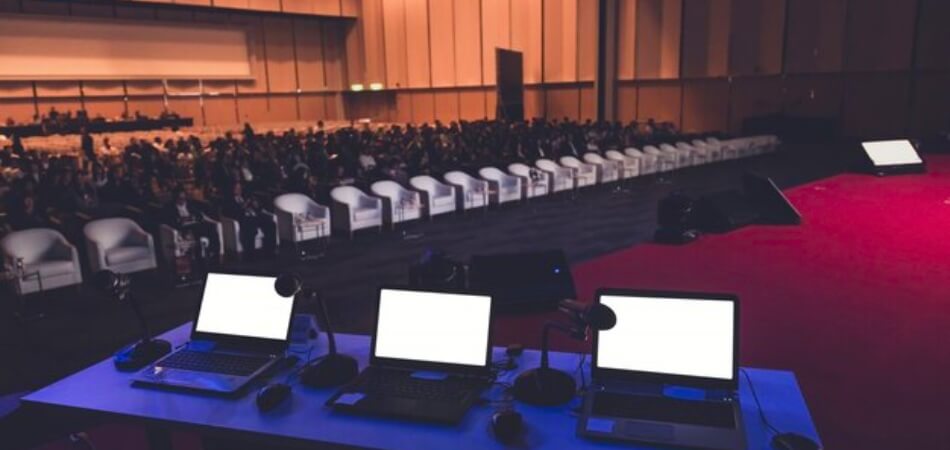Every event planner knows the gut-wrenching feeling of a technical glitch mid-presentation. Maybe the microphone squeals with feedback or the video feed goes mysteriously dark. The success of a conference often hinges on getting the technical details right. So, what are the essential AV requirements for conference?
Your meeting AV checklist may include monitors, projectors, built-in LCD displays or screens, speakers, microphones, and video cameras. Even the most compelling presentation can fall flat without a comprehensive understanding of these tools.
But fear not! By the end of this blog, you’ll have a clear guide on how to ensure your event’s audiovisual setup runs seamlessly, making your next conference a resounding success.
Basic Overview of AV Needs
The ambiance of any event is significantly influenced by its audiovisual setup. Proper AV integration ensures smooth communication. It’s the foundation of any successful conference.
A comprehensive understanding of the must-have AV gear for conferences is paramount for any event planner. This isn’t just about the equipment but also knowing its optimal usage. Correct placement and settings can magnify any presentation’s impact.
Audiences nowadays expect clear visuals and crisp audio during presentations. This clarity requires a blend of modern technology and expert handling. From microphones to projectors, each piece plays a crucial role.
It’s not merely about listing the equipment but understanding their interplay. Coordination between audio, visual, and lighting ensures immersive experiences. A meticulous approach to AV can elevate any conference’s stature.
AV Requirements for a Conference
When planning an event, having the right AV requirements for conference is crucial for creating a smooth and engaging experience for attendees. Here’s a detailed look at what you’ll need to consider.
Audio Equipment
Microphones: Choose a mix of handheld, lapel (lavaliere), and podium mics to accommodate different speakers and settings. Ensure they have a good sound quality and can minimize background noise.
Speakers: Select high-quality speakers that can fill the room without distortion. Consider using multiple speakers for larger venues to ensure everyone can hear clearly.
Mixing Console: A mixing console allows you to control audio levels and balance between different microphones and sources. It’s essential for larger conferences with multiple speakers.
Visual Equipment
Projectors or Screens: Depending on your venue size, use high-resolution projectors or large screens to display presentations and videos clearly. Make sure they are positioned for optimal visibility from all angles.
Monitors: For panel discussions or workshops, consider using monitors on stage to help speakers see their slides or notes without turning away from the audience.
Presentation Tools
Laptops and Software: Ensure that the speakers have access to laptops equipped with presentation software (like PowerPoint or Keynote) and test compatibility with the AV system ahead of time.
Clickers and Remotes: Provide presenters with clickers to smoothly navigate their slides without being tethered to their laptops.
Lighting
Stage Lighting: Proper lighting is essential for visibility and creating the right atmosphere. Use adjustable lights to highlight speakers and important areas without causing glare on screens.
Ambient Lighting: Ensure the room has adequate lighting for networking breaks or workshops while still being adjustable for presentations.
Video Recording and Streaming
Cameras: If you plan to record or livestream the event, use high-quality cameras that can capture clear footage from multiple angles.
Streaming Equipment: Ensure you have the necessary equipment for streaming, including reliable internet connections and encoding software.
Technical Support
On-Site AV Technicians: Having skilled technicians on hand is vital for troubleshooting any issues that arise during the conference. They can ensure everything runs smoothly and assist speakers with setup.
Power Supply
Outlets and Extension Cords: Ensure there are enough power outlets available for all equipment, including laptops and chargers. Use extension cords or power strips as needed.
Accessibility Considerations
Assistive Listening Devices: Consider providing devices for hearing-impaired attendees to ensure everyone can engage fully.
Captioning Services: Offering live captioning can enhance accessibility for all participants, especially in larger venues.
By thoughtfully addressing these AV Equipment for Conferences, you can create a seamless, engaging experience that enhances learning and networking opportunities at your conference. Ultimately, the right AV setup not only supports the speakers but also ensures that attendees feel connected and involved throughout the event!
Why is AV Required for a Conference?
Audiovisual elements in the modern conference landscape aren’t just accessories; they’re essentials. They breathe life into presentations and foster deeper audience engagement. But why is AV so indispensable? Here are some of the reasons why it’s required for a conference:
Enhanced Engagement
AV tools captivate attendees, immersing them in presentations. Multimedia presentations, for instance, cater to various learning styles. This inclusivity ensures broader information retention among diverse audiences.
Professional Projection
A seamless AV setup underscores a conference’s professionalism. High-quality visuals and audio reflect meticulous planning. They emphasize the value attendees gain from participating.
Efficient Communication
Clear audio and sharp visuals streamline communication. When speakers can handle technical glitches, their message resonates. Attendees leave with the intended insights, feeling enriched. Setting Up Live Translation at Conferences can remove awkward language hurdles.
Interactive Possibilities
Incorporating AV fosters interactive, dynamic sessions. Tools like audience polling or live Q&A sessions encourage active participation. This two-way communication fosters a more prosperous learning environment.
Global Reach
With the rise of virtual attendance, AV tools bridge geographical gaps. Quality audio and video enable remote participation. This expands a conference’s reach, making knowledge genuinely borderless.
Understanding the significance of AV in conferences goes beyond mere logistics. It’s about harnessing technology to amplify voices, foster global connections, and create memorable learning experiences for all attendees.
Types of Conferences Requiring AV
Conferences take various forms, each tailored to specific industries, audiences, and goals. The common thread? A vital dependence on audiovisual tools to amplify their impact.
Corporate Conventions
Business gatherings thrive on polished presentations. AV tools project professionalism, ensuring messages resonate with clarity. Crucial data and insights need clear, visual representation for maximum impact.
Networking events often feature keynote speeches. Quality AV enhances these presentations, solidifying corporate relationships. Moreover, multimedia demos often differentiate products in competitive markets.
Educational Symposia
Academic conferences are hotbeds of knowledge exchange. Proper AV support ensures that research findings are clearly conveyed. Charts, graphs, and videos can elucidate complex concepts effectively.
Moreover, panel discussions and debates are symposium staples. AV setups guarantee that arguments are audible and understood. It’s pivotal for knowledge transfer in such settings.
Cultural Festivals
Arts and cultural events lean heavily on sensory experiences. For film screenings or live performances, AV perfection is non-negotiable. Visual and audio elements must seamlessly blend for artistic impact.
Workshops during these festivals often engage in multimedia learning. Artists might showcase techniques using visual aids. Here, AV components play a pivotal role in art dissemination.
Tech Expos
These events are where technological advancements shine. Interactive displays demand top-tier AV integration. Attendees expect impeccable audiovisuals when engaging with future-focused tech.
Furthermore, product launches or demos are expo highlights. A memorable launch necessitates a flawless AV backdrop. It amplifies the innovation and drives home the technological message.
The marriage of conferences and AV tools isn’t just for enhancement; it’s necessary. Regardless of the type, the success of these gatherings often hinges on impeccable audiovisual execution.
How Does Fulfilling the AV Requirements Benefit a Conference?
The ripple effects of comprehensive AV provisions in a conference setting can’t be understated. These tools don’t just serve logistics; they elevate experiences. In doing so, a conference gets benefited from it. Here are some of the benefits of fulfilling the AV requirements:
Audience Immersion
A well-executed AV strategy engages attendees deeply. Multisensory presentations grip audiences, enhancing message retention. This immersion fosters a more prosperous, more impactful learning environment.
Efficient Content Delivery
The essence of any conference lies in effective communication. With quality AV, complexities are unpacked with clarity and precision. Attendees absorb key takeaways without sifting through technical noise.
Professionalism Showcase
Flawless AV execution speaks volumes about organizational prowess. A glitch-free event underscores meticulous planning and expertise. It amplifies the brand’s professionalism in attendees’ minds.
Greater Accessibility
Diverse audiences come with varied needs. Quality AV ensures inclusivity, catering to different auditory and visual requirements. Everyone, regardless of ability, remains engaged and informed.
Feedback Collection
Post-event feedback is gold for organizers. Interactive AV tools, like polling systems, garner real-time reactions. This feedback shapes future events, ensuring they’re even more tailored.
Frequently Asked Questions
What does AV include?
AV, or audiovisual, includes all the equipment and technology used to capture, transmit, and display sound and images. This encompasses microphones, speakers, projectors, screens, cameras, and lighting systems. Together, these elements enhance presentations, making them engaging and impactful, and creating a memorable experience for attendees.
How do I choose the right microphones for my conference?
To choose the right microphones for your conference, consider the venue size and speaker types. Handheld mics work well for dynamic discussions, while lavalier mics offer hands-free convenience for presenters. Test various options beforehand to ensure clear audio, and prioritize quality to enhance the overall attendee experience.
Do I need technical support during the conference?
Yes, having technical support during the conference is crucial. On-site technicians can quickly troubleshoot any issues, ensuring that microphones, projectors, and other equipment run smoothly. Their expertise allows you to focus on the event and engage with attendees, making the overall experience more enjoyable and stress-free for everyone involved.
What lighting should I use for a conference?
For a conference, use adjustable stage lighting to highlight speakers and presentations without creating harsh shadows. Soft, diffused lighting helps set a welcoming atmosphere, while ambient lighting ensures attendees are comfortable. Avoid overly bright lights that can cause glare on screens, ensuring a pleasant viewing experience for everyone.
What should I consider when selecting a projector?
When selecting a projector, consider the venue size and lighting conditions. Look for a high brightness rating (measured in lumens) for visibility, and ensure the resolution meets your needs—at least 1080p is ideal. Also, check connectivity options to ensure compatibility with your devices for a seamless presentation.
Final Thoughts
It’s abundantly clear that in the ever-evolving sphere of events, the audiovisual aspect isn’t a mere backdrop but the heart of the show. The AV requirements for conference are paramount to ensuring that every attendee, whether in-person or virtual, grasps the content to amplify the essence of what’s being communicated.
These requirements, more than just technicalities, serve as bridges connecting ideas, facilitating interactions, and nurturing professional ambiance. Any misstep in AV can create a ripple effect, overshadowing the primary objective.
But with the proper understanding and approach, these tools can transform an ordinary gathering into an extraordinary experience. Embracing the AV requirements for a conference is a commitment to excellence, inclusivity, and memorable engagements.








